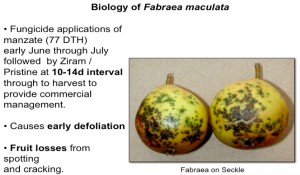 The principle pests of pear production in the Northeastern US are pear psylla, Cacopsylla pyricola (Foerster), and Fabraea leaf spot, Fabraea maculata, and to a lesser extent the obliquebanded leafroller and codling moth. The two primary pests cause premature defoliation, reduced size, quality and yield of fruit, followed by premature decline and eventual death of susceptible pear varieties. Sign of psylla injury are evident in leaf scorch, sooty mold on interior fruit and fruit russeting of Bartlett.
The principle pests of pear production in the Northeastern US are pear psylla, Cacopsylla pyricola (Foerster), and Fabraea leaf spot, Fabraea maculata, and to a lesser extent the obliquebanded leafroller and codling moth. The two primary pests cause premature defoliation, reduced size, quality and yield of fruit, followed by premature decline and eventual death of susceptible pear varieties. Sign of psylla injury are evident in leaf scorch, sooty mold on interior fruit and fruit russeting of Bartlett.
We are presently between overlapping pear psylla generations with a 4th generation to continue through September Bosc harvest. As of August 3rd, few eggs were present with nymphs near threshold in untreated Bartlett.
San Jose scale are emerging this week during its second generation. The use of 1% oil in seasonal management of pear psylla will significantly reduce the pest in pear blocks.
In New York (Chapman and Lienk, 1971), there is one full and one partial generation of codling moth (CM) in a year. Presently CM is mating and laying eggs for the beginning of the 2nd generation. If this insect has caused injury in the past, the use of insecticides to management both pear pylla and CM should be considered.
In larger trees the challenge for pear psylla management has predominately been coverage, especially in the tops of the tree. We have seen orchards this year with overwhelming psylla populations, even after timely applications and use of higher volume. Some of the issue with loss of control may be related to wind speed from the airblast fan as droplets move quickly past the leaf and into the drive row. Slowing fan speed so that the spray moves just beyond mid line of the tree would get the material where its most needed. Suckering trees in mid-late June-July, when suckers can be pulled in dry weather to avoid fireblight, often dramatically reduces psylla populations as psylla prefer to lay eggs and develop on young growing leaf tissue. Sucker removal will also improve spray penetration and coverage.
We’ve had very little rainfall over the past weeks to help remove young nymphs. Dry weather and these near drought conditions will reduce the spread of fabraea in orchards that have reduced control of the disease. However, this is ideal conditions for pear psylla to develop and injure foliage. The use of summer applications to manage overlapping pear psylla generations will be essential as drier conditions continue in the region.

Insecticide resistance has resulted in lower levels of pear psylla insecticide susceptibility, reducing effectiveness of current pest management strategies. Agri-Mek has had very limited control in most orchards with near failure in a few smaller orchards with isolated populations.
Recent studies conducted at the HVRL have demonstrated excellent control of the pear psylla using two unique OMRI products. The pre-bloom applications of the kaolin clay product Surround WP (anhydrous aluminum silicate) and post-bloom of a highly refined horticultural oils (HRO’s) have been used successfully in season long insect management programs to maintain psylla populations below economic thresholds. As with all applications for this pest, coverage with 1% oil is everything.
Furthermore, applications of highly refined horticultural oils (PureSpray, BioCover) were observed suppressing the impact of Fabraea leaf spotting and subsequent reduction in defoliation in plots treated with horticultural oil compared to untreated trees. Oil should not be used as a substitute for fungicide management yet will help in suppression of the disease when used in psylla management efforts.
It is important to note that oil should never be used as a concentrate tank mix; its exclusive use should be limited to a dilute 1% application for pear psylla management. Phytotoxicity to Bartlett and other non-russet varieties will likely result at rates above 1%. The use of 1% oil should be limited to application temperatures below 80F under and excellent drying conditions.
The study was conducted in a commercial Hudson Valley pear orchard in Milton, NY demonstrating the commercial use of these two OMRI products as pest management tools for pear psylla management to achieve commercial levels of control. Additional variables of air induction nozzles compared to commercial hollow disk nozzles in airblast applications were used to study the effects of off target drift; sprayer speed and volume were employed across field plot treatments.
The need for season long management of Fabraea using applications of fungicides at ten day to two-week intervals reduce the additional application costs of bi-weekly HMO applications for post bloom pear psylla management through the incorporation of horticultural oils to the fungicide program.



